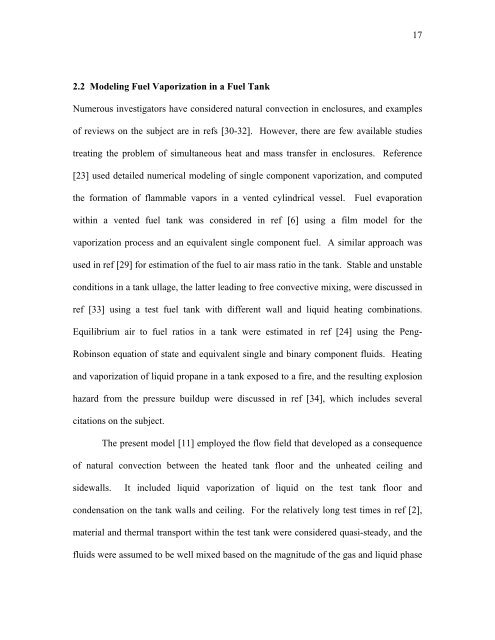Vaporization of JP-8 Jet Fuel in a Simulated Aircraft Fuel Tank ...
Vaporization of JP-8 Jet Fuel in a Simulated Aircraft Fuel Tank ...
Vaporization of JP-8 Jet Fuel in a Simulated Aircraft Fuel Tank ...
You also want an ePaper? Increase the reach of your titles
YUMPU automatically turns print PDFs into web optimized ePapers that Google loves.
2.2 Model<strong>in</strong>g <strong>Fuel</strong> <strong>Vaporization</strong> <strong>in</strong> a <strong>Fuel</strong> <strong>Tank</strong><br />
Numerous <strong>in</strong>vestigators have considered natural convection <strong>in</strong> enclosures, and examples<br />
<strong>of</strong> reviews on the subject are <strong>in</strong> refs [30-32]. However, there are few available studies<br />
treat<strong>in</strong>g the problem <strong>of</strong> simultaneous heat and mass transfer <strong>in</strong> enclosures. Reference<br />
[23] used detailed numerical model<strong>in</strong>g <strong>of</strong> s<strong>in</strong>gle component vaporization, and computed<br />
the formation <strong>of</strong> flammable vapors <strong>in</strong> a vented cyl<strong>in</strong>drical vessel. <strong>Fuel</strong> evaporation<br />
with<strong>in</strong> a vented fuel tank was considered <strong>in</strong> ref [6] us<strong>in</strong>g a film model for the<br />
vaporization process and an equivalent s<strong>in</strong>gle component fuel. A similar approach was<br />
used <strong>in</strong> ref [29] for estimation <strong>of</strong> the fuel to air mass ratio <strong>in</strong> the tank. Stable and unstable<br />
conditions <strong>in</strong> a tank ullage, the latter lead<strong>in</strong>g to free convective mix<strong>in</strong>g, were discussed <strong>in</strong><br />
ref [33] us<strong>in</strong>g a test fuel tank with different wall and liquid heat<strong>in</strong>g comb<strong>in</strong>ations.<br />
Equilibrium air to fuel ratios <strong>in</strong> a tank were estimated <strong>in</strong> ref [24] us<strong>in</strong>g the Peng-<br />
Rob<strong>in</strong>son equation <strong>of</strong> state and equivalent s<strong>in</strong>gle and b<strong>in</strong>ary component fluids. Heat<strong>in</strong>g<br />
and vaporization <strong>of</strong> liquid propane <strong>in</strong> a tank exposed to a fire, and the result<strong>in</strong>g explosion<br />
hazard from the pressure buildup were discussed <strong>in</strong> ref [34], which <strong>in</strong>cludes several<br />
citations on the subject.<br />
The present model [11] employed the flow field that developed as a consequence<br />
<strong>of</strong> natural convection between the heated tank floor and the unheated ceil<strong>in</strong>g and<br />
sidewalls. It <strong>in</strong>cluded liquid vaporization <strong>of</strong> liquid on the test tank floor and<br />
condensation on the tank walls and ceil<strong>in</strong>g. For the relatively long test times <strong>in</strong> ref [2],<br />
material and thermal transport with<strong>in</strong> the test tank were considered quasi-steady, and the<br />
fluids were assumed to be well mixed based on the magnitude <strong>of</strong> the gas and liquid phase<br />
17
















